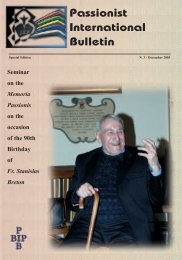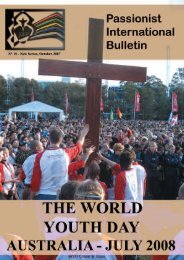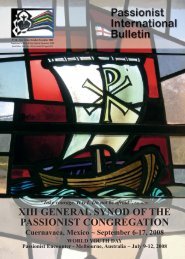The Curia Informs22Consequently, (a) during public worship in publicchurches and oratories, even those currentlyexisting, only those relics that are designated asgenuine or which are accompanied by the documentof authentication by a cardinal, the localOrdinary (excluding the vicar general, exceptwith a special mandate) or of some ecclesiasticalauthority who posses the faculty to authenticateby means of an apostolic indult (.e.g. thePostulators general; can. 1283, §§ I-2). (b) Theapprobation of the local Ordinary should begiven according to the spirit of the TridentineCouncil, i.e. the Ordinary will make his owndeliberations, after having consulted with theologiansand prudent advisors, and as always, guidedby the criteria of truth and piety. In dubiouscases, prior to resolving any controversy, theOrdinary will listen to the decision of theMetropolitan and of the bishops of the provincein the Provincial Council. Where this not possible,recourse to the Holy See should be sought(Tridentine Council, sess. XXV; AAS, 18 (1926),p. 262. (c) When previously approved relics forpublic veneration are transferred to another diocese,the verification of the local Ordinary shouldbe sought not for a new approval but so that he isaware of an approbation that was previouslygiven; and then he will give authorization for theexposition of thesame in worship.(d) The localOrdinaries willprudently removefrom worship anyrelic which theyknow with certaintyis notauthentic (can.1284). (e) Relics,whose authenticshave been lost,should not be publiclydisplayedexcept followinga decision of thelocal Ordinary,excepting the vicar general not in possession of aspecial mandate (can. 1285 § I). (f) Nevertheless,antique relics may be venerated in worship asthey have been in the past, unless by means ofconvincing argumentation they are deemed to bebogus or altered (can. 1285 § 2). (g) Whoeverconsciously confects or sells false relics ipsofacto incurs excommunication reserved to theRelics prepared by the General PostulationOrdinary (can. 1326). The reason for this severesentence on behalf of the Church is to precludeignorance, lucrative enterprises and superstitiousfaith that this very delicate matter may cause." 1Given the current practice, one can also objectciting the that the Council of Trent belongs to thedistant past and that the legislation of the Code of1917, from which the norms come that were citedabove, in no longer in use and which was supersededas is stated in the Preface to the 1983 Code,where there can be found the following interestinglines: "When the meeting of this group tookplace at the beginning of month of April 1968,there was general agreement concerning thenecessity to not include in the new Code any lawsconcerning the liturgy, or norms concerning theprocesses of beatification and canonization, ornorms concerning relationships of the Church adextra." 2The exclusion of norms concerning Causes ofBeatification from the Code of 1983 requires anew ad hoc legislation which is found in theApostolic Constitution of 1983 DivinusPerfectionis Magister, and in the Norme dellaCongregazione delle Cause dei Santi approvedand ratified again by the Pope in 1983 throughthe office of the then Prefect, Cardinal Palazziniwho basically, in the case of relics, restates: "To_____________________the sameCongregation (ofthe Causes ofSaints) is left thedecision regardingall matters concerningtheauthenticity andthe conservationof relics." 31. P. PALAZZINI, Reliquie, Enciclopedia Cattolica, X, 758-759.2. ENCHIRIDION VATICANUM 8, CODICE DI DIRITTO CANONICOpromulgato da S. S. Giovanni Paolo II, Prefazione, p. 39.3. ENCHIRIDION VATICANUM 8, DIVINUS PERFECTIONIS MAG-ISTER, Titolo II, art. 3. Cfr. REGOLAMENTO DELLA S. CON-GREGAZIONE PER LE CAUSE DEI SANTI, Titolo I, art. 1, pp. 467-499 e in Appendice a R. RODRIGO, Manuale delle Cause diBeatificazione e Canonizzazione, Roma 2004, pp. 378-490.
The Curia InformsGiven that "the causes of the canonization of theservants of God are regulated by special pontificallaw" (CIC 1983, can 1403 §1), which is not insertedin the new code of 1983, if not for those dispositionsthat refer to universal law, not containinganything contrary to the new Code, we can thereforeconclude that there is nothing that was statedby Cardinal Palazzini has been modified, exceptfor the norm 2g concerning the excommunicationreserved to the ordinary - no longer in force - butwhich, however, still prohibits the confection anddistribution of false relics By "false" I think itwould be good to clarify that by this is meant notonly the supposed authenticity of the particle, butalso the use of false seals and authentics, so thatthe veracity of a relic is not compromised by itsresemblance to authentic seals, but by authority toissue decrees of authenticity, without which, a fallacyis created by which one is morally responsible.One recent example that illustrates the particularlaw cited above was the peregrination of theurn containing the remains of the Founder at theProvincialate of the <strong>Passionist</strong> Sisters of St. Paulof the Cross in Ciampino, at the end of March2004. Under my direction, the nulla osta wasrequested from the bishop where therelics were located, i.e. the CardinalVicar of Rome, and from the bishopof the place where the urn would bebrought in pilgrimage, i.e. the bishopof Albano. The two documents,together with the request of thePostulator, were sent to the HolySee, i.e. to the Congregation for theCauses of Saints. This Congregationissued an Istructio directed to boththe local Ordinaries, requestingfrom the first one that a tribunal becomposed consisting of theDelegate, the Promotor and aNotary to verify the seals and toprepare the urn, properly sealed, forthe pilgrimage; the second, thereceiving Ordinary, was requestedto inspect the integrity of the sealsupon arrival so as to permit veneration.When the urn was returned toRome, again the Tribunal of theVicariate had to verify the sealsaffixed by the Episcopal Delegateand the placement of the remain ofSt. Paul of the Cross under the altar.The final seals of the Vicariate closed the encasementthat sealed the tomb. With the reports ofthose that accompanied the relics - the MotherProvincial and the two bishops, a folder was preparedand was sent to the Holy See which is theultimate guarantee of the authenticity of the relics.The Postulator provided small relics to be left as agift to the pastors. Such relics were placed in thecaeto which was affixed the authentic seal in redwax and were accompanied by documents ofauthenticity which only he can issue with hisembossed seal.This required process confirms the use and theneed for such procedures. Therefore, according tothe norms expressed above, and exemplified in thecase cited, and which are still valid and permittedby the Congregation for the Causes of Saints, itcan be stated that:It is the sole right of the bishop, not of otherlocal ordinaries or religious - since it is not theirarea of competence - by their proper authority andin communion with the Holy See, to guarantee theauthenticity of relics and how they are managed.In the case of canonical recognition of the mortalremains of a saint, as well as their removal to aplace other than that church were they are pre-Relics of St. Gemma Galgani23
















